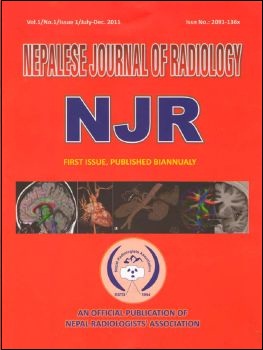Current Status of Endovascular Repair of Aortic Dissections
DOI:
https://doi.org/10.3126/njr.v1i1.6331Keywords:
Endovascular RepairAbstract
Aortic dissection is a medical emergency and can quickly lead to death, even with optimal treatment. The Stanford classification is widely used and is in close relationship to clinical practice, as type A dissections require primary surgical repair whereas type B dissections are treated medically as initial treatment with surgery or endovascular repair reserved for any complications. Multi-slice CT is fast emerging as the investigation of choice to establish the diagnosis and plan treatment strategies in aortic dissection. The therapeutic strategies differ for treatment of an acute dissection compared to a chronic dissection. Most institutions favor a ‘complication specific’ approach for type B dissections with medical anti-hypertensive treatment and the use of beta-blockers as the primary therapy. Surgery or endovascular repair is reserved for patients with recurrent pain, life-threatening complications or rapid aortic expansion. Procedural success during endovascular repair for type B aortic dissection is reported in 99.2+ 0.1% of patients. Overall survival rates of 96.9% at 30 days, 96.7% at 6 months, 96.4% at 1 year, 95.6% at 2 years, and 95.2% at 5 years are reported after endovascular repair in Type B aortic dissections. There is evidence that endovascular repair may be non-inferior to surgery in this group of patients. Device designs and management algorithms are still evolving. More validated clinical data is necessary to define the role of endovascular repair in the management of type B aortic dissections.
DOI: http://dx.doi.org/10.3126/njr.v1i1.6331
Nepalese Journal of Radiology Vol.1(1): 92-98
Downloads
Downloads
Published
How to Cite
Issue
Section
License
This license enables reusers to distribute, remix, adapt, and build upon the material in any medium or format, so long as attribution is given to the creator. The license allows for commercial use.




